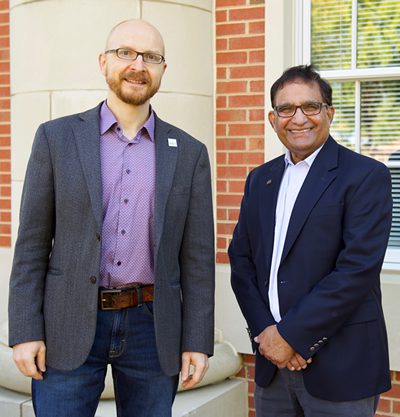Driving innovation in energy, medicine, defense, communications, Center for Metamaterials receives third round of NSF funding

For over a decade, researchers and students in UNC Charlotte’s Center for Metamaterials have studied and created materials that can bend, absorb, transmit and otherwise manipulate light and sound waves that pass through them.
“The capabilities of these engineered materials are enormous,” said Ish Aggarwal, center director. “These materials can suppress or amplify light and sound waves. Once developed, these materials could even hide an aircraft in the sky just as you would see in science fiction movies.”
Generally speaking, metamaterials are specially engineered materials with properties that differ substantially from those found in nature.
 In recognition of innovative collaboration with industry and government partners in metamaterials research, the UNC Charlotte center has joined a select handful of Industry/University Collaborative Research Centers (I/UCRCs) nationwide to earn a third phase of National Science Foundation (NSF) funding. The NSF support for administering the center is expected to total $250,000 over the next five years.
In recognition of innovative collaboration with industry and government partners in metamaterials research, the UNC Charlotte center has joined a select handful of Industry/University Collaborative Research Centers (I/UCRCs) nationwide to earn a third phase of National Science Foundation (NSF) funding. The NSF support for administering the center is expected to total $250,000 over the next five years.
Researchers, students and industry and government collaborators in the UNC Charlotte center focus primarily on sensing, imaging, antennas and energy harvesting. Plans call for new research in medical and acoustic metamaterials.
The research considers a broad range of commercially relevant applications that can help address problems in renewable energy, transportation, avionics, consumer electronics, homeland security and defense, health and medical technology, communications and other areas. Several specific applications developed in the UNC Charlotte center have transitioned to industry.
While considering the practical applications, the UNC Charlotte center addresses foundational scientific questions related to the physical processes that occur when electromagnetic or mechanical waves interact with subwavelength-sized structures. A fundamental limitation of most metamaterials is that they are inherently narrowband, functional over a small range of frequencies. The challenge is to engineer material properties that are broadband, tunable, and able to be manufactured in a cost-effective way.
“The beauty of our program is that it takes advantage of the ingenuity and innovativeness of academia, combined with the engineering, fabrication and implementation of industry,” Aggarwal said. Students and faculty at the University suggest the projects, and the collaborating industry and government partners select projects and fund the work.
The center receives strong support from industry and government partners through membership fees. The partners’ financial support typically goes toward student stipends and tuition, offering a valuable resource for the Optical Science and Engineering interdisciplinary doctoral program.
One of the doctoral students, Paige Stinson, who is currently an intern with center industry partner UC Conec with support from NSF, has gained expertise and relationships through the center.
“The center has provided me with the resources I need to accomplish the fundamental research goals of my Ph.D. while allowing the creative flexibility to simultaneously explore my interests and present new ideas,” Stinson said. “The cleanroom facilities that we have access to in the center are the foundation of my current research, particularly our Nanoscribe. Perhaps even more impactful, the center has allowed me to have a direct relationship with not only fellow researchers in the center but with industry-leading companies and government research labs.” A Nanoscribe is a 3-D printer for objects with dimensions of one billionth of a meter.
Graduate and undergraduate students conduct research with guidance from faculty and center members. Students, many of whom come from underrepresented groups in science and engineering, are prepared as highly skilled scientists and engineers. One of the biggest advantages for the partners is the ability to assess and hire students working with the center.
Another doctoral student, Micheal McLamb, has learned to focus his research to address real-world problems through direct interaction with center partners.
“These collaborators follow your work through the years and know your name,” McLamb said. “Student involvement with the center enhances the desirability and chances of employers hiring a student pending graduation. Currently, I conduct research on reflective and absorbing metamaterials. I am collaborating with several scientists from Air Force Research Labs (AFRL) on a couple of projects involving these materials. This collaboration has led to a paid internship with AFRL funded by the National Science Foundation.”
For these students and others, the collaborative research has led to co-authored publications, including in the journals Optics Letters, Thin Solid Films and Plasmonics.
“It is largely because of the hard work of our faculty directing this center, both now and in the past, and because of our relationships with our partners, that we have been able to achieve this milestone with the continued NSF support,” said Glenn Boreman, chair of the Department of Physics and Optical Science. “We have a very talented set of faculty participants from the College of Liberal Arts & Sciences and the Lee College of Engineering in particular.”
Leadership in the center in addition to Aggarwal includes co-director Tino Hofmann and founding director Michael Fiddy, all faculty in the Department of Physics and Optical Science in the College of Liberal Arts & Sciences. Also partnering with UNC Charlotte is Clarkson University as an affiliated site.